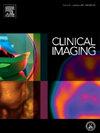Evaluating the association between knee osteoarthritis severity and descending genicular artery caliber
IF 1.5
4区 医学
Q3 RADIOLOGY, NUCLEAR MEDICINE & MEDICAL IMAGING
引用次数: 0
Abstract
Introduction
Genicular artery embolization (GAE) is performed with the intent of reducing a pathologic increase of neovascularity in patients with osteoarthritis (OA) related knee pain. It is unclear whether knee OA is associated with upstream changes in genicular artery caliber. The purpose of this study was to evaluate the relationship between knee OA severity and descending genicular artery (DGA) caliber.
Materials and methods
A retrospective review of lower extremity computed tomographic (CT) angiography studies from July 2022 to March 2023 was conducted. Patients with Kellgren-Lawrence (KL) grade 0–4 knee OA were included. The caliber of the descending genicular artery (DGA) and the superficial femoral artery (SFA) at the level of the DGA origin were measured.
Results
In the left and right leg respectively, a strong positive correlation was demonstrated between KL grade and DGA caliber (r = 0.68, p < 0.01), (r = 0.59, p < 0.01), and KL grade and DGA/SFA caliber (r = 0.71, p < 0.01), (r = 0.59, p < 0.01). No significant association was demonstrated between SFA caliber and KL grade in the right and left leg, respectively.
Discussion
This retrospective study reveals significant positive correlations between the severity of knee OA, and caliber of the DGA. These findings suggest that joint level changes of OA may be associated with upstream changes in genicular artery caliber.
评估膝关节骨关节炎严重程度与膝降动脉口径之间的关系
膝动脉栓塞术(GAE)的目的是减少骨关节炎(OA)相关膝关节疼痛患者新血管的病理性增加。目前尚不清楚膝关节OA是否与上游膝动脉口径改变有关。本研究的目的是评估膝关节OA严重程度与膝降动脉(DGA)口径之间的关系。材料与方法回顾性回顾2022年7月至2023年3月下肢CT血管造影研究。Kellgren-Lawrence (KL) 0-4级膝关节OA患者纳入研究。测量膝降动脉(DGA)和股浅动脉(SFA)在膝降动脉起始处的直径。结果左、右腿KL分级与DGA口径呈显著正相关(r = 0.68, p <;0.01), (r = 0.59, p <;0.01), KL等级和DGA/SFA口径(r = 0.71, p <;0.01), (r = 0.59, p <;0.01)。在右腿和左腿的SFA口径和KL等级之间分别没有明显的关联。本回顾性研究显示膝关节OA的严重程度与DGA的口径之间存在显著的正相关。这些发现表明OA关节水平的改变可能与上游膝动脉口径的改变有关。
本文章由计算机程序翻译,如有差异,请以英文原文为准。
求助全文
约1分钟内获得全文
求助全文
来源期刊

Clinical Imaging
医学-核医学
CiteScore
4.60
自引率
0.00%
发文量
265
审稿时长
35 days
期刊介绍:
The mission of Clinical Imaging is to publish, in a timely manner, the very best radiology research from the United States and around the world with special attention to the impact of medical imaging on patient care. The journal''s publications cover all imaging modalities, radiology issues related to patients, policy and practice improvements, and clinically-oriented imaging physics and informatics. The journal is a valuable resource for practicing radiologists, radiologists-in-training and other clinicians with an interest in imaging. Papers are carefully peer-reviewed and selected by our experienced subject editors who are leading experts spanning the range of imaging sub-specialties, which include:
-Body Imaging-
Breast Imaging-
Cardiothoracic Imaging-
Imaging Physics and Informatics-
Molecular Imaging and Nuclear Medicine-
Musculoskeletal and Emergency Imaging-
Neuroradiology-
Practice, Policy & Education-
Pediatric Imaging-
Vascular and Interventional Radiology
 求助内容:
求助内容: 应助结果提醒方式:
应助结果提醒方式:


